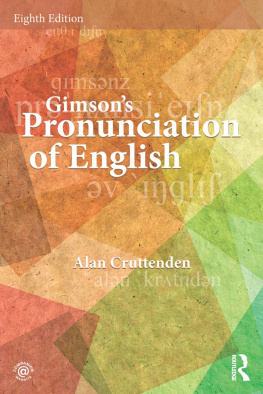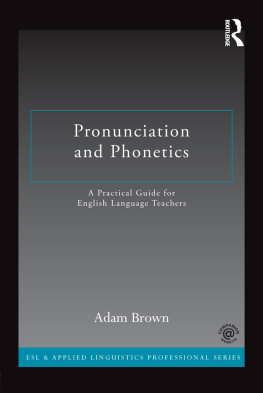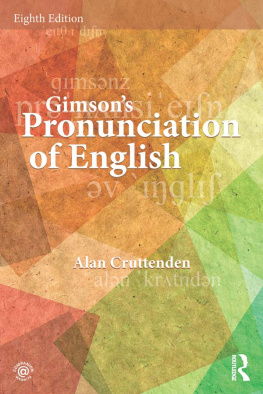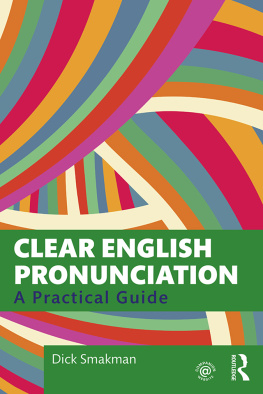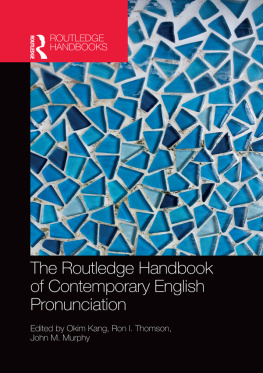Gimsons Pronunciation of English
Since it was first published in 1962, Gimson's Pronunciation of English has been the essential reference book for anyone studying or teaching the pronunciation of English.
This eighth edition has been brought fully up to date, describing what is now termed General British (GB) as the accent of principal consideration and relinquishing the outdated expression RP, and the accompanying transcription has been updated in line with recent changes in pronunciation. This latest edition also includes completely rewritten chapters on the history of the language and the emergence of a standard, alongside an explanation for the change from RP to GB.
A further bonus to this important text is its extensive and attractive new companion website (www.routledge.com/cw/cruttenden), which now includes moment-by-moment commentaries on videos showing the articulation of all GB consonants and vowels in spoken phrases, as well as cross-referencing between the book and these videos. The companion website also includes new recordings of Old English, Middle English, and Early Modern English, and features links to recordings of recent and current GB with comments and transcriptions.
Comprehensive yet accessible, Gimson's Pronunciation of English remains the indispensable reference book for anyone with an interest in English phonetics.
Alan Cruttenden is Emeritus Professor of Phonetics, University of Manchester,and Fellow of the Phonetics Laboratory, University of Oxford.
Under Alan Cruttenden's excellent stewardship, Gimson 's Pronunciation of English continues to be the ultimate authority on the subject of English phonetics; no student or teacher of this subject can do without it.
Cruttenden's rejection of the term Received Pronunciation in favour of General British is, in my opinion, timely and his transcriptional revisions to certain vowel symbols reflective of current trends in General British pronunciation.
The commentaries on articulation added to the MRI videos on the companion website are particularly elucidating. I will definitely be referring my students to this informative material.
Jane Setter, University of Reading, UK
This well-respected volume continues to be an invaluable authority on the pronunciation of English, and the on-going efforts by Alan Cruttenden to keep it updated are exceptionally welcome. This latest update will ensure this volume continues to be an essential resource for anyone teaching or researching the pronunciation of English, especially with the continued development of on-line resources to accompany the book.
David Deterding, University of Brunei, Darussalam
There are books which you need to read, possibly from the library, and books which you need to own. Together with a pronouncing dictionary of English, this excellent update of Gimson's classic description of the pronunciation of English, now completely rewritten by Alan Cruttenden, should be on the bookshelf of every serious student or teacher of English.
Daniel Hirst, CNRS, Aix-Marseille University,
France, and Tongji University, China
Unique and unrivalled, of Cruttenden's four successive brilliant re-workings and updatings upon the famous Gimson foundation, this is the most remarkable yet, not least for its groundbreaking new audio-visual companion website.
Jack Windsor Lewis, formerly of the University of Leeds, UK
Gimsons Pronunciation of English
Eighth Edition
Alan Cruttenden

First edition published 2014
by Routledge
2 Park Square, Milton Park, Abingdon, Oxon OX14 4RN
and by Routledge
711 Third Avenue, New York, NY 10017
Routledge is an imprint of the Taylor & Francis Group, an informa business
2014 Alan Cruttenden
The right of Alan Cruttenden to be identified as author of this work has been asserted by him in accordance with sections 77 and 78 of the Copyright, Designs and Patents Act 1988.
All rights reserved. No part of this book may be reprinted or reproduced or utilised in any form or by any electronic, mechanical, or other means, now known or hereafter invented, including photocopying and recording, or in any information storage or retrieval system, without permission in writing from the publishers.
Trademark notice: Product or corporate names may be trademarks or registered trademarks, and are used only for identification and explanation without intent to infringe.
First edition published as An Introduction to the Pronunciation of English by Edward Arnold 1962
Seventh edition published by Hodder Education 2008
British Library Cataloguing in Publication Data
A catalogue record for this book is available from the British Library
Library of Congress Cataloging in Publication Data
Cruttenden, Alan, 1936
Gimsons pronunciation of English / Alan Cruttenden. Eighth Edition.
pages cm
Includes bibliographical references and index.
1. English languagePhonetics. 2. English languagePronunciation. I. Gimson, A. C. Introduction to the pronunciation of English. II. Title. III. Title: Pronunciation of English.
PE1135.C78 2014
421.58-dc23
2013026284
ISBN: 978-0-415-72174-5 (hbk)
ISBN: 978-1-4441-8309-2 (pbk)
ISBN: 978-0-203-78496-9 (ebk)
Typeset in Times New Roman
by Graphicraft Limited, Hong Kong
IPA Chart, http://www.langsci.ucl.ac.uk/ipa/ipachart.html, available under a CreativeCommons Attribution-Sharealike 3.0 Unported License. Copyright 2005 International Phonetic Association.
Contents
The phonetic detail of the pronunciation of British English has already been described in several excellent works, notably those of Daniel Jones. This present book, written after a number of years of teaching the spoken language both to English students and to foreign learners, sets out to place the phonetics of British English in a larger framework than has been customary. For this reason, emphasis is given to the function of the spoken medium as a form of communication. Some treatment of the historical background and the linguistic implications of the present sound system is included, as well as information concerning the acoustic nature of English sounds. Those sections in , general advice to the foreign learner is included.
The book is intended to serve as a general introduction to the subject which will encourage the reader to consult more specialized works on particular aspects. Though my own views and observations intrude both in the material and in its presentation, much of the information given is derived from the numerous sources quoted in the Bibliography. In particular, new evaluations, which seem to me to reflect more nearly the current trend of RP forms, are made of the phonetic characteristics of certain phonemes. In the acoustic field, where so much remains to be investigated and where research proceeds so rapidly, an attempt has been made to sum up the results of work done in the post-war period, though many of the conclusions must as yet be regarded as tentative. It was tempting to apply to British English a logical, elegant and economical phonemic analysis such as is now commonplace in the United States, involving a very much simplified phonemic notation. If this has not been done, it is mainly because a type of analysis was required which was explicit on the phonetic level as well as reasonably tidy on the phonemic level; it seemed easier, for instance, to deal with phonetic developments and variants in terms of the largely traditional (for British English) transcription which has been used.
Next page
